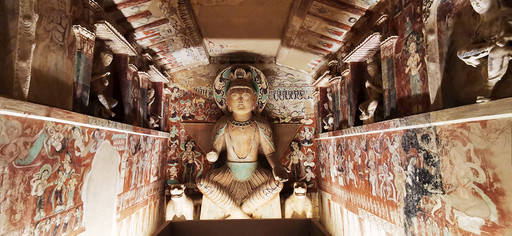
. > WHAT'S NEW > TOPLINE
Museums build up public cultural programs
Author : BAN XIAOYUE Source : Chinese Social Sciences Today 2023-07-07

Cave replicas on display at the Wanlin Art Museum of Wuhan University, in Wuhan, Hubei Province Photo: CFP
Since the 18th National Congress of the Communist Party of China (CPC), China’s museum initiatives have experienced remarkable and unprecedented growth under the strong leadership of the CPC Central Committee with Comrade Xi Jinping at its core.
Cultural construction
At the recent Eighth Forum of Curators of China University Museums in Beijing, He Xiaolei, deputy director of the Department of Museums and Social Cultural Relics at the National Cultural Heritage Administration, said that the last decade represents a golden period for China’s cause of museums. Museum practitioners have been committed to three historical missions in the field.
In the first instance, the country is ushering in explorations for a suitable path towards modernized Chinese museums. The systems of themed museums, such as the Yangtze River, the Yellow River, the Grand Canal, and the Belt and Road, have come into being. Prominent achievements have also been made in terms of museum clusters in the Beijing-Tianjin-Hebei Region, the Yangtze River Delta, and Guangdong-Hong Kong-Macao Greater Bay Area. The cities of Beijing, Xi’an, and Luoyang have emerged as prominent hubs for museums. The systems of annual museum reports and quality appraisal are increasingly well-fledged, featuring marked modern governance.
China has made persistent efforts to meet the people’s ever-growing needs for a better life, He Xiaolei continued. These efforts include initiatives to ensure free public access to museums, enhance personalized and humanistic services, and introduce widely-acclaimed exhibitions showcasing fine traditional culture. By taking such actions, China effectively responds to the fundamental question of for whom museums are built.
He Xiaolei emphasized China’s commitment to promoting civilizational exchanges and mutual learning. The country has actively organized various events, including the UNESCO High-Level Forum on Museums and the General Assembly of the Alliance for Cultural Heritage in Asia. These endeavors aim to strengthen cultural exchanges with others, encompassing areas as museum collection, preservation, research, display, and personnel training. By doing so, China seeks to foster stronger people-to-people connections and contribute to the development of a human community with a shared future.
In the view of Liu Shuguang, chairman of the Chinese Museums Association, museums are epitomes of national cultural soft power, and serve as indispensable platforms for cross-cultural exchanges. Functioning as civilizational palaces, they exude grandeur and knowledge, while also acting with wide accessibility and the ability to transmit cultural values. The integration of these seemingly distinct aspects grants museums unique capabilities that other cultural institutions may lack. In the context of turning China into a country with a strong socialist culture, it is crucial to recognize and affirm the significant role of museums in constructing, showcasing, and enhancing China’s cultural soft power. It is advisable to establish the concept of museum diplomacy within the framework of cultural diplomacy, accompanied by reasonable top-level strategies and corresponding measures. This approach will effectively convey China’s stories on the international stage.
Digital opportunities
China makes continuous efforts to vitalize museum collections and seek befitting development paths in the digital era. Zhou Yu, deputy secretary of the Party committee and deputy director of the Art Exhibitions China, affirmed the opportunities brought forth by the digital era to cultural dissemination in the form of cultural relics and heritage. It has broadened transmission paths and display means, integrating cultural museums and various other sectors.
Niu Huiqing, deputy curator of China Media Museum at the Communication University of China, noted that this museum played a key role in the Ninth Chinese Exposition of Museums and Relevant Products and Technologies. It cooperated with other institutions in launching large-scale convergence media transmission activities, streaming live over more than 100 omni-media platforms, with a viewership of over 34.6 million.
Enhancing the transmissibility of museum culture is becoming a new proposition in the omni-media era, Niu concluded. Convergence media reports based on thematic planning and technology applications unlock greater potential for museum cultural communication to “go viral.”
University museums
Museums and universities share inseparable connections. The first public museum in China, the Nantong Museum, was established to meet the educational requirements of Nantong Normal College. Reflecting on the historical development of cultural museums, Ai Jingfang, deputy secretary general of the Chinese Museums Association, emphasized that their origins can be traced back to universities. It was through the cultivation of museum talent in colleges and universities that the industry was propelled forward. Recognizing the vital role of museums within educational institutions, it is imperative to continue this endeavor with a strong sense of responsibility and mission.
According to Ni Wan, deputy director of the Wanlin Art Museum of Wuhan University, as it unveiled an archaeological exhibit of Dunhuang Caves, the museum employed a great deal of digital technology, encompassing plenty of high-fidelity digital replicas of Dunhuang murals. At the exhibition, Wuhan University conducted professional lectures on subjects such as classical philology, bio-genetics, mural painting art, and remote sensing mapping technology within the exhibition halls. In this manner, university museums serve as a fusion classroom for both teachers and students.
Ye Shengtao made Chinese fairy tales from a wilderness
Ye Shengtao (1894–1988) created the first collection of fairy tales in the history of Chinese children’s literature...
-
How northern ethnicities integrated into Chinese nation
2023-09-18
-
Mogao caves
2023-09-12
-
Mogao Grottoes as ‘a place of pilgrimage’
2023-09-12
-
Time-honored architectural traditions in China
2023-08-29
-
Disentangling the civilizational evolution of China
2023-08-28
-
AI ethics in science fiction
2023-08-23













 2011-2013 by www.cssn.cn. All Rights Reserved
2011-2013 by www.cssn.cn. All Rights Reserved